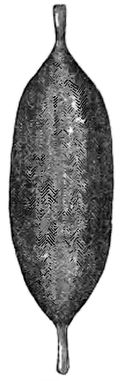 |

|
| FIGS. 131, | 132. |
| (Scale ⅛.) | |
 |

|
| FIGS. 133, | 134. |
| (Scale 1/10.) | |
In Figs. 131-2, 133-4 it will be seen that the handle—the inside length which is usually four inches—is not separated from, but forms a part of the weapon. Such instruments are now rare. In making them, the wood next to the bark and a part of the wood of the tree are used, and great art is necessary in cutting out the piece and perfecting the shape, so as to make the instrument strong and durable. In Figs. 135, 136, and 137 the handle is formed of a separate piece of wood, which, when green, is thrust into holes made to receive the ends. When finished, the handle can scarcely be taken out without breaking the weapon. These figures give different and very instructive examples of the modes of ornamentation in favor amongst the Aborigines.
 |
 |

|
| FIGS. 135, | 136, | 137. |
| (Scale 1/10.) | ||
The weight of a Gee-am is about one pound eleven ounces. Some are lighter, but seldom are any of them heavier.
Mr. George Bridgman, of Mackay, in Queensland, has sent me a very curious shield. The back, front, and sides are shown in the engraving. It is rudely but profusely ornamented, with shallow incised

